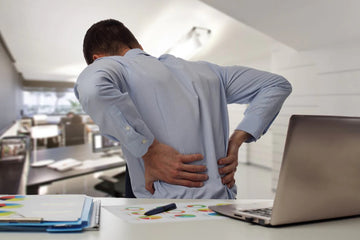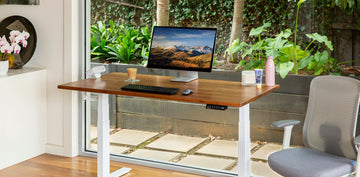Chronic pain is like that unwanted guest who overstays its welcome, lingering long after the initial warning signs have packed up and left.
The Australian government reports that people with chronic pain are 5 times more likely to be significantly limited in everyday activities. And that goes for work-related activities where we actually spend most of our time. At work, where we are all trying to be top-notch, chronic pain can be a real challenge. People dealing with it might find it tougher to focus, hit deadlines, or be the team player they want to be.
We believe that every individual deserves a workspace that not only meets their professional needs but also supports their health and comfort. So let’s explore chronic pain with this comprehensive guide, where we tackle the unique challenges of managing work-related chronic pain and provide solutions to create an environment that prioritises well-being and comfort.
Understanding Chronic Pain
First things first – change starts with awareness. When pain persists for over three months or extends beyond the expected healing period, it is classified as chronic. According to Safe Work Australia, one-third of employed Australians suffer from chronic back pain. It is rather a discouraging figure, but at least you know you are not alone.
Furthermore, chronic pain goes beyond mere physical discomfort, influencing both social and psychological aspects of an individual's life, especially in the workplace where you are expected to be the most productive. Whether stemming from musculoskeletal issues, inflammatory conditions, or neuropathic disorders, chronic pain requires a thoughtful and personalised approach to management. The first step involves breaking free from hard-core habits that have been holding your pain hostage.
What Happens if You Don’t Address Chronic Pain
Ignoring chronic pain at work is like trying to get things done while carrying a kangaroo in your backpack. It directly affects your ability to stay productive, making your tasks feel like an unnecessary struggle. The enduring physical and psychological impact may result in increased absenteeism (missing work) or presenteeism (being physically present at work but not fully engaged or productive).
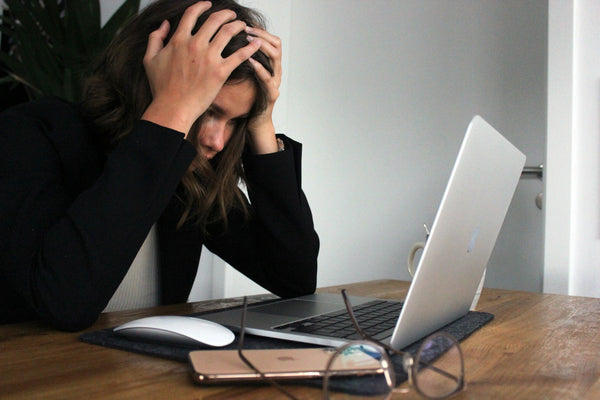
On the emotional side, neglecting chronic pain can result in heightened stress levels and frustration. Waiting for the pain to go away on its own is like sweeping problems under the rug; it only guarantees you'll trip over them later! It's a fragile balance between your professional and personal life, and chronic pain can tip the scales. The bottom line? Taking care of chronic pain early on is key to preventing a chain reaction of challenges.
Common Types of Work-Related Pain
Whether it's the lower back strain from prolonged sitting, the neck and shoulder tension due to desk ergonomics, or the wrist and hand discomfort from repetitive tasks – we've all experienced it. And let's not forget that throbbing hip pain when you suddenly stand up after many hours of sitting cramped up in your uncomfortable office chair. Understanding these daily challenges is key. Let's navigate these common discomforts together so you can focus on your tasks with greater ease and comfort.
1. Neck Pain
Neck pain at work often finds its roots in the daily grind. It's the consequence of a desk that doesn't quite match up, demanding a constant, uncomfortable tilt of the neck. Prolonged sitting doesn't help either – the neck muscles will sooner or later bear the brunt of stationary hours.
2. Back Pain
Lower and upper back pain, caused by prolonged sitting, is often due to poor posture and ergonomic issues. When you slouch or sit in an unsupportive chair, it can disrupt the spine's natural alignment, leading to muscle compensation and discomfort. Additionally, a sedentary lifestyle, combined with repetitive tasks and insufficient lumbar support, can worsen muscle stiffness and tension.
3. Wrist Pain
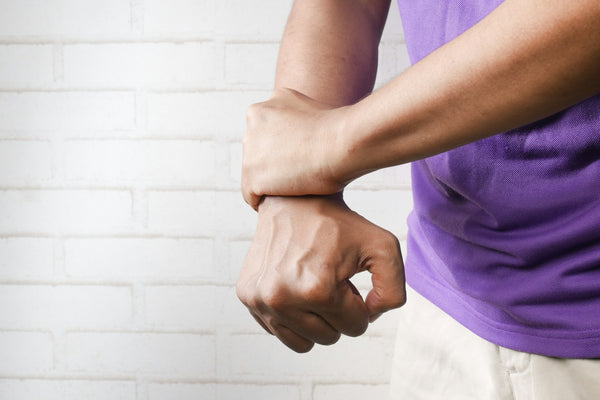
Repetitive movements and poor ergonomics are common causes of wrist pain at work. Activities that require frequent typing, clicking, or the repetitive use of hand-held tools can strain the tendons in the wrist and result in discomfort. Additionally, incorrect wrist positioning due to an improperly adjusted desk, keyboard, or mouse can worsen the problem.
4. Hip Pain
Work-related hip pain is often caused by sitting for long periods in chairs that are poorly designed or in static positions without taking breaks. Remaining in a seated position for long hours shortens the muscles that support the hips and consequently causes pain upon standing or walking. Reduced physical activity can further worsen hip discomfort.
The Downsides of Sedentary Lifestyle
Are you noticing the pattern? Most of the causes including work-related chronic pain have one common factor – a chair! According to the World Health Organization (WHO), 60 to 85% of the world population, in both developed and non-developing countries, lead sedentary lifestyles, thus making it one of the more serious yet insufficiently addressed public health problems of our era.
A sedentary lifestyle, characterised by prolonged periods of sitting or inactivity, significantly aggravates the challenges associated with chronic pain. It is a common chain reaction, as extended periods of inactivity contribute to muscular rigidity and weakness, compromising joint flexibility, and causing muscular imbalances that can further aggravate an ongoing problem. And it doesn’t end there. A sedentary routine often correlates with weight gain, placing additional stress on joints and worsening pain symptoms.
Beyond the physiological aspects, the psychological impact of a sedentary lifestyle, including heightened stress and anxiety can launch a person into an enchanted circle. Consequently lowering the motivation to do necessary physical activity. Our bodies are meant to move and will not tolerate our static lifestyle.
How to Relieve Pain at Work
Relieving pain at work involves adopting a proactive approach to create a more comfortable and supportive environment. It is an ongoing process. In other words, chronic pain needs to become chronic healing. Easier said than done, right? Here are some easy guidelines to achieve a pain-free working environment. It certainly won’t hurt to try them!
1. Always Listen to Your Body
To keep your body in check and avoid work-related discomfort, embrace an introspective approach to your physical well-being. Your body knows best!
Tune into any hints of strain or discomfort, and don't underestimate the power of short breaks if your work involves sitting for long periods or repetitive tasks. Stand up, stretch, and move around periodically to prevent stiffness and reduce the likelihood of pain. If this is too challenging, try scheduling breaks by setting reminders. Incorporate regular exercise, including stretching routines, to strengthen muscles and improve flexibility.

Be conscious of maintaining good posture, both while sitting and standing. Experiment with fluid movements by consciously and seamlessly shifting between different postures to find what works best for you at any given moment. Include micro-movements, rotate your wrists, stretch your neck gently, and flex your ankles to keep your body engaged and alleviate pain.
Stay hydrated throughout the day to prevent muscle cramps, and prioritise adequate sleep, as lack of restorative sleep can contribute to muscle fatigue and increased susceptibility to pain. Adopting these practices will contribute to a conscious and proactive approach to preventing work-related pain. Your body will be grateful!
2. Ergonomic Excellence Without Compromises
The foundation of effective chronic pain management lies in ergonomic design. Ensuring that your desk, chair, and monitor form a cohesive unit is crucial for promoting a neutral and comfortable posture, thereby reducing strain on the body.
Personalisation is key for optimal comfort and functionality; we are all built differently after all. Tailor your workstation to your unique needs by setting your desk at an optimal height to maintain a neutral wrist and neck position, also supporting the natural curve of your spine. Additionally, If your work has you chained to a chair, make it a comfortable one. Invest in an ergonomic chair with sufficient lumbar support and reduce the likelihood of worsening chronic pain conditions.
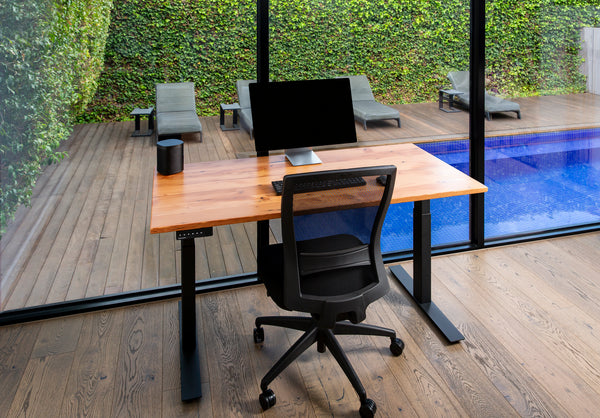
Better yet, embrace sit-stand flexibility, alternating between sitting and standing throughout the day. This will alleviate pressure on your lower back and joints, and the smooth transitions will facilitate easy incorporation of movements into your work routine, promoting circulation and alleviating stiffness.
3. Standing is the New Sitting
Here is a pro tip – elevate your comfort with a standing desk featuring adjustable height and a sturdy build. Upgrading your workstation with a sit-stand desk introduces much-needed flexibility as it facilitates smooth transitions between sitting and standing positions. This proactive adjustment helps diminish muscular stiffness that can result from prolonged inactivity, ensuring a more dynamic and therefore healthier working environment.

Additionally, by allowing you to alternate between sitting and standing, a standing desk promotes mobility and better posture, reducing the risk of prolonged sedentary behaviour and associated health issues. This not only helps alleviate back and neck pain but also enhances circulation and boosts energy levels.
But don’t just take our word for it. The option to stand while working has been linked to increased productivity and heightened focus. The International Journal of Environmental Research and Public Health published this study in 2021, finding that the intervention of sit-stand desks while working led to reduced pain in the neck and shoulders, improved health outcomes, and increased productivity over three months. Regular desks don’t stand a chance against these results!
4. Mindful Workstations
Mindful workspaces extend beyond ergonomic solutions, incorporating elements that evoke tranquillity and peace of mind. Though it may not directly impact your posture, it significantly influences your mood, having a positive effect on overall comfort and relaxation. Besides, cultivating mindfulness contributes to stress reduction – a crucial aspect of chronic pain management.
Furthermore, the adaptability of your workspace allows for the creation of an inviting environment that aligns with your preferences. Customise your workspace with elements that evoke calmness, such as soothing colours, gentle lighting, or a touch of nature with a small plant. Tend to dedicate a few moments each day to mindfulness practices, using your workspace for short meditation sessions or deep breathing exercises. It's all about setting priorities. Create some space in your busy schedule and put your well-being first.

Mindful workspaces not only enhance personal well-being but also elevate the collective spirit, creating a safe place where stress dissipates, focus intensifies, and productivity soars. The philosophy of mindfulness influences every aspect, ensuring that the workspace becomes a sanctuary of calm and inspiration.
5. Communicating is Key
Advocate openly for necessary accommodations, be it an ergonomic chair or additional breaks, to create an inclusive workplace that caters to diverse needs. Foster understanding by educating colleagues about chronic pain and the adjustments that can make a significant difference, contributing to a more supportive work environment. Based on the statistics mentioned earlier, the chances are high that you will find someone who understands exactly how you feel.
Put your health first and explore flexible work arrangements, such as adjustable work hours or remote work options. This flexibility allows individuals with chronic pain to better manage their symptoms and balance their work responsibilities.
Final thoughts
If the solution to chronic pain lies in increased mobility, it only means we should start by reevaluating our routine and start right where many of us spend a big chunk of our day – the workplace. Customising our workstations plays a significant role in this remedy. This involves tailoring working environments to accommodate the unique needs of each individual. It's not just about ensuring optimal ergonomics; it also requires integrating mindfulness practices and prioritising overall well-being and inclusivity at work.
However, battling the sedentary lifestyle has to start with every individual and willingness to change for the better. Listening to our bodies is of crucial importance to a more active life and healthier work-life balance. If mobility is indeed the key, then standing desks are our best allies. Embracing sit-stand patterns should become the new standard in every working environment.

